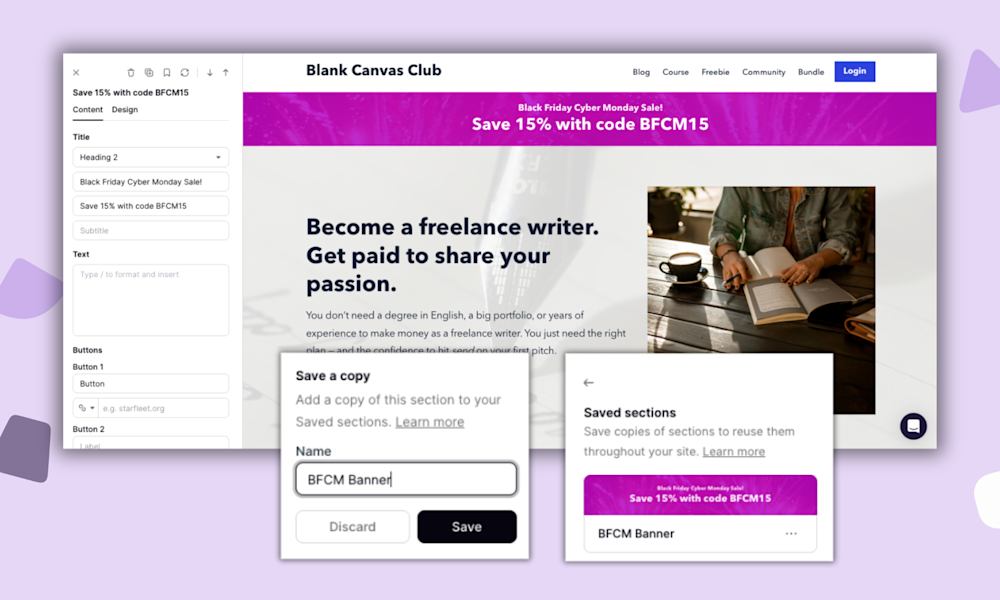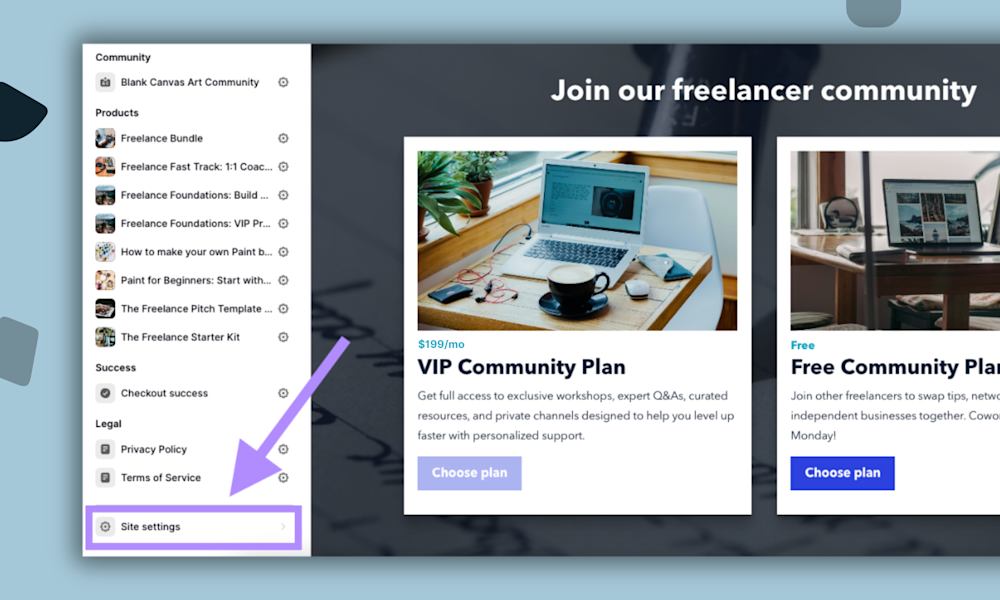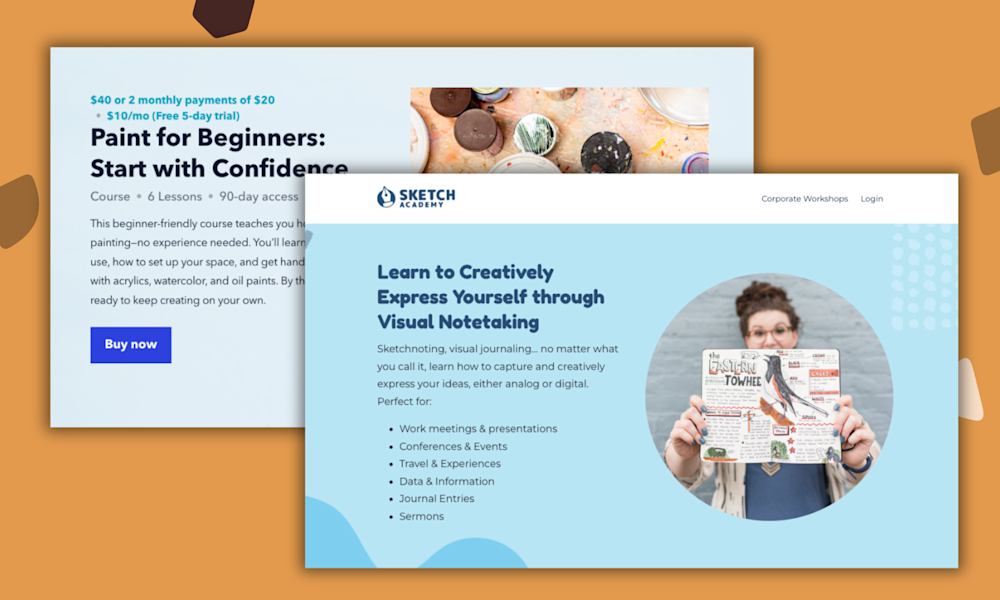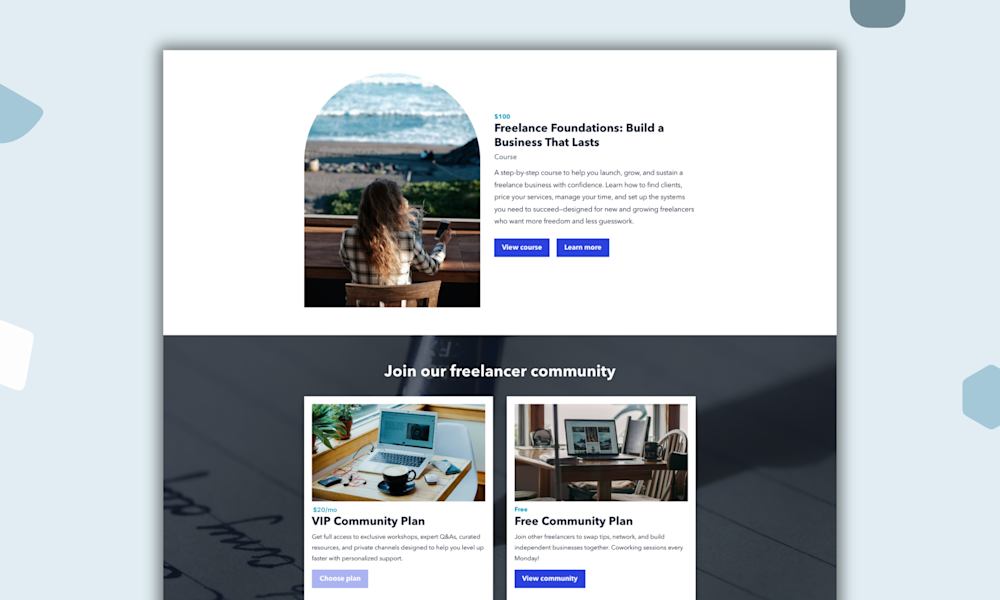As a language teacher, you already have a skill people are willing to pay for. But turning that skill into a business that actually pays the bills? That’s a whole different challenge.
You’ll likely need a website, a way to take payments, a booking system, a place to share resources, and tools to communicate with students. It’s a lot to manage, and when those systems don’t play nicely together, you end up spending more time troubleshooting tech than teaching.
Then there’s the marketing side. How do you find new students when there are thousands of other teachers (and endless free YouTube videos) competing for attention? And once you do find them, how do you make sure they keep coming back?
Without a plan for attracting and retaining students, you’re stuck in a constant cycle of hustling for new clients just to make ends meet.
I saw this firsthand when I worked as an online teacher. So many talented colleagues burned out, not because they didn’t love teaching, but because managing the tech and constantly chasing new students left them exactly zero hours to do the work they actually cared about.
The good news is it doesn’t have to be that complicated.
With the right setup, you can build a profitable online language business that runs smoothly, brings in new students automatically, and keeps them engaged so they stick around for the long haul. Plus, you won’t need a web developer or 10 different logins to manage everything.
In this guide, we’ll cover the three simple things you need to start your online teaching business today and plan for long-term success:
-
A website so language learners can find you
-
Digital products so people can buy from you
-
An email list to turn one-time students into regulars
Podia has all of these features built in, and plenty of language teachers have already joined us to create thriving, sustainable businesses. (You’ll meet some of them in this blog post!) Let’s take a look at how you can simplify your setup and free up your brain space to do what you actually love: teach your students.
Your basic setup for teaching languages online
To get your language business off the ground, you only need three things: a simple website, a way for customers to learn from you, and an email list so you can stay in touch with everyone.
We’ll get these pieces set up first, and then we’ll talk about how to consistently find new customers, bring in revenue, and grow your business in the future.
First, you need a website so people can find you
Your website is your home base on the internet. It’s where you’ll send prospective clients so they can learn more about you, and it’s a place to house your products, share your schedule, display testimonials, and get discovered by search engines. Unlike social media, your website is a space you control, with no ads, algorithms, or distractions.
In the past, setting up a website was a big endeavor — one that usually involved hiring a developer or working with a designer to make it look the way you like. But today, things are much simpler.
You can set up a basic website in an afternoon using tools like Podia, so that’s where we’ll start today.
For now, let’s focus on your website homepage. This page should include:
-
Who you are, with information about your teaching background and credentials
-
The languages and levels you teach
-
The types of lessons, courses, or programs you offer
-
Who your target customers are, what pain points they’re experiencing, and how you can help them reach their goals
-
Past student testimonials or reviews
Write down this information so you have it handy, and then open up Podia.
If you don’t have an account yet, you can start a 30-day free trial here. All accounts come with a website ready to go, out of the box.
Open the Podia Dashboard and click “Website” in the left sidebar. Then click on your home page to customize the design. You can click the plus sign anywhere on the page to add new website sections, like a text block, image block, about me section, or featured section.
You can also add an email sign-up box (email is already connected in Podia, so it’s just a click) and information about your products and courses as you make them, like Martainspanish does on her home page.
Marta’s home page has her email newsletter sign-up form, information about her teaching background and method, and easy links to free resources, ebooks, courses, and 1:1 offers. Students can learn about her and what she does and easily find out where to take the next step with her business.

Now you have a place to send people when they want to learn more about you, and a place to promote the products you set up in the next step.
Next, you’ll make your digital products
A product is the thing that students buy from you. It can be a 1:1 lesson, an ebook, a course, a workshop, or a membership, for instance.
Many online teachers start with simple 1:1 lessons, but you can offer any kind of product or experience you like. Here are some common options and examples you can use as a jumping-off point.
1:1 language lessons in Podia
Offering 1:1 language lessons is great for connecting with students and providing personalized support. There’s also less upfront work since you don’t need to make a comprehensive course or write a full ebook to get started.
For example, Amandine Pope from Au French Corner offers 1:1 virtual lessons, in-person classes, and group lessons. She also offers a 2-hour pronunciation workshop to help learners perfect their speaking.

In Podia, you can set this up by adding a coaching product. Give your product a title, description, and price, and then connect your Google Calendar, Calendly, SavvyCal, etc.
And after your student pays, they’ll automatically receive a link to book a spot on your calendar. You can also send automated emails to your students after they sign up to remind them what to prepare for your session.
Sell a language ebook in Podia
Ebooks work great for teaching vocabulary, grammar, and culture for second language learners. English teacher Tiffani from Study with Tiffani sells a series of nine different vocabulary ebooks, as well as ebooks about passing English interviews, IELTS speaking exams, and sentence structure.

To sell an ebook in your online language teaching business, you’ll start by writing your book in a tool like Google Docs, Word, Canva, or any word processor of your choice. Then, you can export your book as a PDF file.
In Podia, create a digital download product type and add your ebook file. Give your product a title, description, and price. Press publish to set it live, and now whenever someone buys your ebook, they’ll automatically get access to your PDF.
Create a language course in Podia
Another option is to create a language course for your students. Courses allow you to easily add videos and audio files, which are key to language acquisition. You can organize your content into modules and lessons so students have a clear path to follow.
Grace from Thai with Grace offers several language courses in her product lineup, including a comprehensive video course that takes students from zero Thai to conversational. This beginner course has over 150 lessons and 16 hours of video content, so true beginners can start speaking and building confidence.

When you set up your online course in Podia, you can organize your materials into sections, and each section can have as many lessons as you like. Within your lessons, you can add videos, audio files, images, embeds, downloads, text, and any other content you’d like to share.
After you’ve added your course content and set your pricing, you’ve got some more options to customize your program. You can add a set start date so all students begin at the same time, drip content slowly to ensure students don’t rush, enable comments and discussion forums so students can learn together, and bundle your course with other products to add more value.

As your business grows, you can also make language memberships, communities, webinars, product bundles, subscriptions, and virtually any other type of product you like. But let’s keep it simple for now.
Pick one product to make (a 1:1 lesson is quickest!) and publish it. Next, you’ll make your sales page.
Set up your product landing page
For each product you make, Podia automatically generates a sales page with a buy-now button that takes your customer to checkout so they can easily purchase your product. Your sales page works out of the box, but you can also customize it in just a few seconds.
Click the three dots next to your product to edit the sales page using the Podia website builder.

Just like we did for your home page, you can click the plus sign anywhere on your sales page to add new website sections, like FAQs, testimonials, and product details.
Publish your changes, and voila! Your page is ready to share with customers.
Everything is connected in Podia, so your students can visit your website, click on a product, check out, pay, and get access to the materials all in one spot.
Finally, you need an audience and an email list to stay in touch
Alright, let’s talk about your students, the most important part!
Once you’ve got:
-
A website where students can find you
-
Products they can buy like 1:1 lessons, digital downloads, ebooks, and courses
It’s time to start filling seats.
The main way we’ll do this is with an email list. Your email list is simply a list of email addresses of customers, prospective students, and followers who have opted to hear from your business. You can set up your email list in Podia, and there are built-in tools to stay in touch with your people long into the future.
With an email list, you can regularly talk to your clients and leads right in their inbox — away from the noise of social media.
Our data shows that Podia customers who also use Podia Email have over 11x more customers on average compared to those who don’t, so here are a few common ways to get that boost for yourself:
-
Send email newsletters to stay in touch with your audience. Share helpful tips, new products, schedule openings, and other resources to help them on their learning journey.
-
Automatically send out your new blog posts as emails when you press publish to get more eyes on your work and stay top of mind.
-
Schedule automated emails to follow up with new subscribers. If someone joins your list but doesn’t buy anything, you can automatically send them information about your paid programs a few days later.
-
Schedule automated emails about additional products to existing students: If someone signs up for a course or product, you can automatically send details about your other offers a few weeks later, once they’ve had time to digest the material.
Simply put, sending emails lets you talk directly to the people who have chosen to hear from your business, so you now have a direct pathway to share your products, courses, and 1:1 lesson availability with everyone interested.
But beyond just sending good emails, you also need a way to consistently get new people onto that list so they can learn from you.
There are a few ways to do this.
-
If you already have a customer list that has agreed to be emailed, you can import those people directly into your Podia account. Easy peasy.
-
If you’re starting from scratch (many people are, no worries!), I recommend adding a free lead magnet to your website. A lead magnet is a free resource like a PDF, checklist, template, or intro session that people can download in exchange for joining your email list.
Lead magnets are effective because you can directly address your prospective clients’ questions, goals, and sticking points. Think about what kinds of struggles your students are facing at this stage in their journey, and create a free product that starts to address the solution.
Lead magnets work because they build trust and get your students closer to their goal (language fluency) while also showing off your skills as an educator.
For instance, Grace from Thai with Grace offers a 10-day mini course as her free lead magnet. This course is designed for beginners who have no knowledge of Thai, and helps them overcome the first hurdles, like greetings, basic questions, pronouns, and numbers.
The program is great for curious beginners and travelers, and anyone who wants to see what Grace’s programs are like. When a new student joins, they’ll also be added to Grace’s audience so she can let them know about other programs in the future.

To set this up, you can create a product in your Podia account and set it to “Free email delivery” (for downloads) or “Free” for courses and coaching offers. Add the product files and details, and then it will be available for people to grab.
Next, share this free resource on your website, social media channels, in the footer of your blog posts, or anywhere else your audience spends time. Let them know that this free resource is available just for them, and that they can get access in seconds when they subscribe.
Okay, now the technical parts of your online business are set up. What now?
How to grow your online teaching business so it can sustain you long term (without working 24/7)
Setting up your website, digital products, and email list is a great start, and the next step is to get more people moving through your business and learning about what you offer.
The goal now is to:
-
Build systems that attract new audience members on autopilot
-
Create products that allow you to teach more people without working more hours.
To do this, here’s what I would do next.
First, continue to share your lead magnet and website on your social media channels and anywhere else you have a following. Make your lead magnet a regular part of your content calendar so new followers can easily get on your email list and start learning from you. You should also link your lead magnet and website in your link in bio, email signature, and video descriptions so it’s very easy for people to find your work.
As your email list grows, get in the habit of sending out a weekly newsletter. In each newsletter, add a sentence reminding people how to book live lessons or sign up for your programs. This keeps your business top of mind and reminds people to circle back to their learning.
Start blogging. Share blog posts that are catered to your target audience, for example:
-
How to count to 100 in my language
-
Cool phrases that make you sound like a local
-
Things you need to know before you travel to [country]
-
Business [language] words you need to know for an interview
At the end of each blog post, share a reminder about your products and offers, as well as a way to join your email list. People can find your blog posts organically through search engines, so it’s a great way to connect with people who are already looking for the topics you teach.

Create products that don’t require 1:1 time from you. For example, self-paced courses, ebooks, and prerecorded content can be a great way to reach more people without working more hours. You can still offer 1:1 language lessons and group sessions if you like, but supplementing with self-paced programs can bring in more revenue in less time.
Consider creating a community for your audience. Communities are a shared space where people can help each other and access resources together. Your community can be free or paid, and it’s a great way to add an interactive element to your business.
Let your existing customers earn money by promoting you. You can do this with an affiliate program, which is also built into Podia. As an affiliate, your previous customers can earn a small commission if they recommend your courses or products to others. They’re incentivized to share your work, and there’s no upfront cost for you since you only pay if they bring you a new sale.
Never stop talking to your audience. The biggest piece of advice I have here is to keep communicating with your customers, students, and audience members. They are the ones you’re creating for, so ask them for feedback and learn about their pain points.
-
Where are people getting stuck with learning your language?
-
What level are your audience members currently at?
-
Are they studying for a language exam?
-
Preparing for an interview?
-
Planning to visit your country on vacation?
You can use this information to create products and free lead magnets that solve the exact problems your audience is describing. Every business is different, and your customers are unique, so hear what they have to say and use that to drive your decisions forward.
A profitable online language business, all in Podia
You’ve got the language skills and a passion for teaching, so the next step is to put everything together so you can share what you love (and earn money doing it!)
To start:
-
Set up a website for your business
-
Create digital products like 1:1 lessons, ebooks, and courses for your customers to buy
-
Set up an email list so you can stay in touch with everyone
-
Create a free lead magnet to get people on that list so you can let them know about your products and offers
Then, focus on building systems that attract new audience members on autopilot and creating products that allow you to teach more people without working more hours.
You can do all of that in Podia, your all-in-one tool for building a website, digital products, and email list. Start your 30-day free trial of Podia now. I can’t wait to see what you teach.



